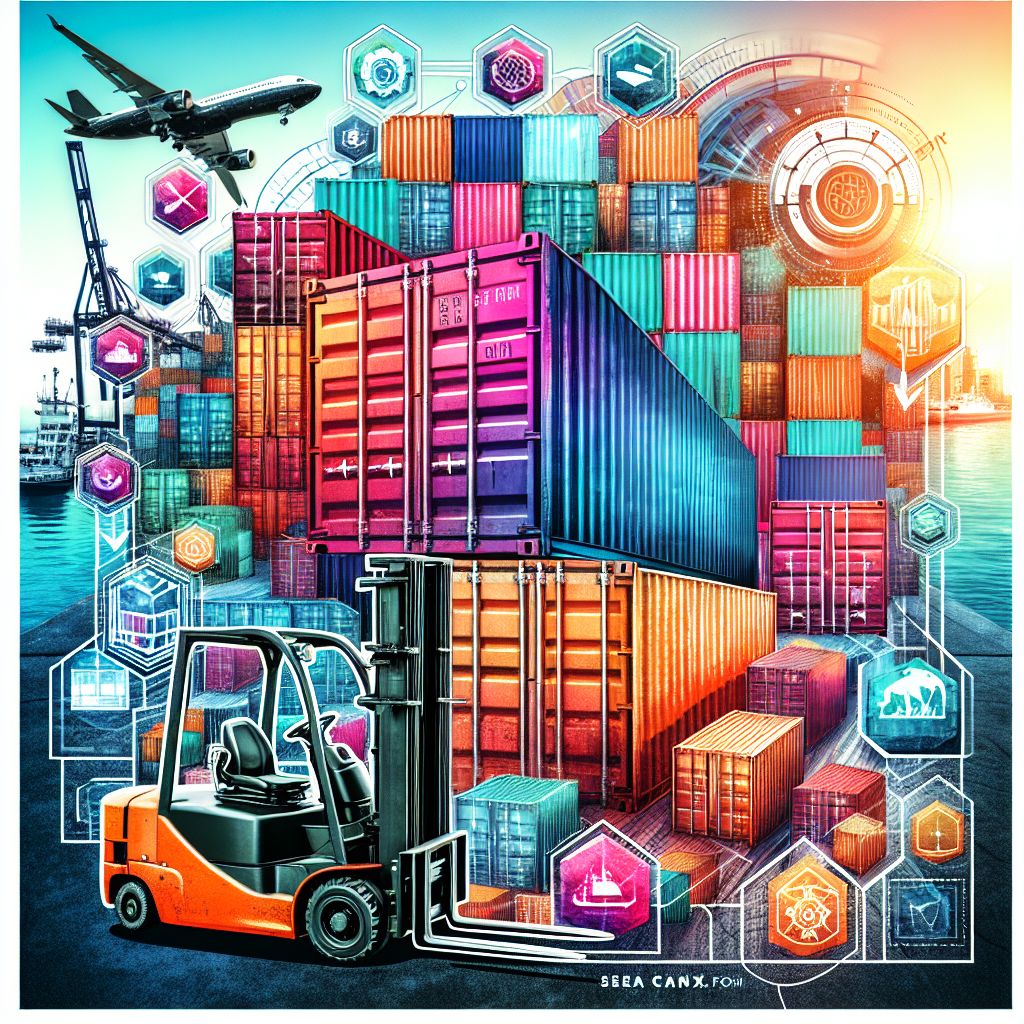
Key Takeaways
- Stacking shipping containers without a crane can be achieved using forklifts or telehandlers, with each having its unique strengths and limitations.
- Forklifts are cost-effective and practical for short-distance moves but may struggle with high stacking.
- Telehandlers offer greater reach and maneuverability in tight spaces, although they can be more expensive.
- Understanding the specific lifting capacities, costs, and operational requirements of each equipment is crucial for efficient container stacking.
- Local regulations and site-specific conditions play a significant role in deciding whether to use a forklift or a telehandler for stacking shipping containers.
Transform Logistics: Stacking Containers with Forklifts & Telehandlers
When you’re in the logistics game, every square inch of space and every minute of time counts. That’s why stacking shipping containers efficiently is not just a nice-to-have, it’s a must-do. But what if you don’t have access to a crane? No problem. We’ve got forklifts and telehandlers to take on the challenge. Let’s dive into how these mighty machines can revolutionize your container stacking, even in the most space-constrained environments.
My Favorite Container Homes Resource
I compared the top 3 Container Home Guides
to discover the ultimate resource!
See my top recommendation here
Core Concepts of Container Stacking
Before we get into the nitty-gritty, let’s understand why stacking containers is so important. It’s all about maximizing space and organizing containers in a way that makes them accessible and secure. Whether you’re working in a shipping yard, construction site, or storage facility, stacking containers allows you to store more in less space, which is essential for optimizing operations and cutting costs.
The Value of Non-Crane Stacking Solutions
Now, you might be thinking, “Why not just use a crane?” Well, cranes are great, but they’re not always practical. They’re expensive, require specialized operators, and aren’t suited for all spaces. That’s where forklifts and telehandlers come into play. They offer the flexibility to stack containers in areas where cranes might not reach or be too costly to operate.
Forklifts in the Spotlight
Forklifts are the workhorses of the warehouse, but they’re also stars when it comes to stacking shipping containers. These powerful lifters can move and stack containers with ease, provided they’re within the forklift’s lifting capacity. Usually, forklifts can handle around 5-6 tons, but it’s always important to check the manufacturer’s specifications to be sure.
Cost Comparisons of Forklift Use
When we talk about cost, forklifts are generally more affordable than telehandlers. They’re not just cheaper to rent or buy; they also have lower operational costs. However, the actual cost can vary based on the forklift’s capacity and whether you’re going for a new, used, or rental model.
Size and Capacity Considerations for Forklifts
- Check the forklift’s lifting capacity against the weight of your containers.
- Ensure the forklift has the reach to stack containers to the desired height.
- Consider the forklift’s size to make sure it can maneuver in your space.
Size matters, and in the case of forklifts, it’s a balancing act between lifting capacity and maneuverability. You want a forklift that’s strong enough to lift your containers but not so large that it can’t move around your site.
Analysis of Forklift Deployment Time
Time is money, and forklifts can save you a lot of it. They’re quick to deploy and can start stacking containers almost immediately. This rapid turnaround is a game-changer for operations needing to adapt quickly to storage demands.
Permit and Approval Processes with Forklifts
Before you get started, you’ll need to ensure you have the right permits and approvals in place. This can include operator certifications, equipment registrations, and safety inspections. It’s a step that can’t be skipped, as it ensures your operation runs smoothly and legally.
Forklift Efficiency Table
| Feature | Forklift | Telehandler |
|---|---|---|
| Cost | Lower | Higher |
| Lifting Capacity | Up to 6 tons | Varies, often higher |
| Maneuverability | Good in open spaces | Better in tight spaces |
| Deployment Time | Fast | Fast |
| Permitting Complexity | Moderate | Moderate |
With the basics of forklifts covered, it’s time to shift our focus to telehandlers and see how they stack up against their forklifting cousins.
Financial Implications of Telehandler Use
Switching gears to telehandlers, we see a different financial landscape. While telehandlers can be more costly upfront compared to forklifts, they bring a level of versatility that often justifies the investment. They can reach higher, maneuver in tighter spaces, and generally lift heavier loads. The cost will vary depending on the model, capacity, and whether you’re buying or renting, but you’re looking at a higher initial outlay for the machine and its operation.
However, it’s important to look beyond the sticker price. Telehandlers can reduce the need for additional equipment on site, such as cranes, which can help streamline operations and save costs in the long run. Plus, the ability to handle a wider range of tasks can translate into fewer idle hours and a higher return on investment.
When considering the financial implications, factor in the maintenance and operational costs as well. Telehandlers may require specialized maintenance, which can add to the overall cost of ownership. But, with proper care, these machines can be a valuable asset for many years.
“A telehandler’s reach and versatility can lead to significant long-term savings, even with a higher initial investment.”
Comparing the Reach and Size of Telehandlers
Now, let’s talk about what really sets telehandlers apart: their reach and size. Unlike forklifts, which have a limited lift height, telehandlers can extend their forks vertically and horizontally, giving them the ability to stack containers much higher. This makes them ideal for sites where vertical space is at a premium.
Size-wise, telehandlers are typically larger than forklifts, which allows them to have a sturdier base for lifting heavier and higher loads. However, this also means they require more space to operate. When choosing a telehandler, you must ensure that your site can accommodate its larger footprint.
Time-to-Operate: Telehandlers vs. Cranes
When it comes to operation time, telehandlers offer a distinct advantage over cranes. They are quicker to set up and can be operated by a single individual, which reduces wait times and increases efficiency on the job site. Unlike cranes, which may require extensive setup and multiple operators, telehandlers can be ready to go in a fraction of the time, making them ideal for projects with tight deadlines or rapid turnaround requirements.
Navigating Regulations for Telehandlers
As with any heavy machinery, telehandlers come with their own set of regulations. These can include operator training and certification, equipment inspections, and job site safety protocols. The regulatory landscape can vary by location, so it’s crucial to understand the specific requirements in your area before incorporating telehandlers into your operations.
Telehandler Efficiency Table
| Feature | Telehandler | Crane |
|---|---|---|
| Cost | Higher initial, potential long-term savings | Very high, with additional operational costs |
| Lifting Capacity | Varies, often higher than forklifts | Highest, suitable for all weights |
| Maneuverability | High in tight spaces | Low, requires large operating area |
| Setup Time | Fast | Slow, complex setup |
| Regulatory Compliance | Moderate, depends on location | High, with stringent requirements |
Comparing telehandlers to cranes, the table highlights the areas where telehandlers excel, especially in cost savings over time and maneuverability. The fast setup time and moderate regulatory compliance also make them an attractive option for many projects.
- When choosing between a telehandler and a crane, consider the cost implications, both short and long term.
- Assess the reach and size requirements of your project to determine if a telehandler is suitable.
- Factor in the time it takes to operate the equipment and the associated regulations.
With the insights into forklifts and telehandlers, it’s time to pit them against each other and see which one comes out on top for your specific needs.
The Great Debate: Forklifts or Telehandlers?
So, which should you choose for your container stacking needs—a forklift or a telehandler? It’s not a one-size-fits-all answer. Your choice depends on several factors, including the specific requirements of your site, the height and weight of the containers you need to stack, and, of course, your budget.
Stacking Options Summary:
| Equipment | Lifting Capacity | Advantages | Disadvantages | References |
|---|---|---|---|---|
| Forklift | 5-6 tons or more | – Cost-effective – Practical for short-distance moves |
– May not be suitable for stacking containers | 1, 2, 3 |
| Telehandler (Reach Forklift) | Varies | – Can lift and maneuver containers in tighter spaces – Longer reach than standard forklifts |
– May be more expensive than standard forklifts | 1, 2, 3 |
| Earth Ramp | N/A | – Simple and cost-effective solution | – Requires additional construction work | 1 |
| Manual Jacking/Pulley Systems | N/A | – Can be used in tight spaces without a crane | – More complicated to set up and use | 1 |
| Gantry Crane | Millions of dollars | – Can lift containers off ships and stack them in high-volume shipping yards | – Extremely expensive | 1 |

Frequently Asked Questions (FAQ)
What Are the Key Benefits of Using Forklifts for Container Stacking?
Forklifts are affordable, easy to operate, and ideal for quick deployment in areas with ample space. They’re also easier to maintain and can be a great choice for lower stacking requirements.
How Do Telehandlers Improve the Efficiency of Container Stacking?
Telehandlers bring greater reach and lifting capacity, which can improve efficiency by reducing the need for additional equipment. Their versatility in tight spaces also makes them a valuable asset in complex stacking scenarios.
Can Shipping Containers Be Safely Stacked Without a Crane?
Yes, with the right equipment and planning, shipping containers can be safely stacked without a crane. Forklifts and telehandlers, when used correctly, can provide a safe and efficient alternative to crane stacking.
What Are the Limitations of Using Forklifts and Telehandlers?
The main limitations of forklifts are their lower lift height and capacity, while telehandlers may be more expensive and require more space to operate. It’s essential to match the equipment to the specific needs of your project.






Leave a Reply